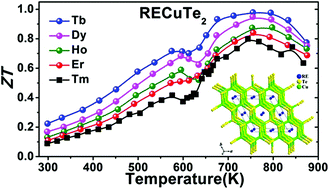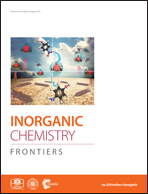Syntheses, structures, and thermoelectric properties of ternary tellurides: RECuTe2 (RE = Tb–Er)†
Abstract
In this work, four ternary rare-earth copper tellurides with a general formula RECuTe2 (RE = Tb, Dy, Ho, Er) were successfully synthesized by a conventional high-temperature solid-state reaction of the elements. These isostructural materials adopted a known TmCuTe2-structure type and contained a 2D honeycomb-like layer built up from CuTe4 tetrahedral building units along the c-axis, with RE3+ located in layers. Moreover, all of them show a first order structure phase-transition, from the low-temperature-phase (LTP, space group: P![[3 with combining macron]](https://www.rsc.org/images/entities/char_0033_0304.gif) m1) to the high-temperature-phase (HTP, space group: P
m1) to the high-temperature-phase (HTP, space group: P![[3 with combining macron]](https://www.rsc.org/images/entities/char_0033_0304.gif) ), due to the Cu atom's re-distribution on the covalent CuTe4-based layer substructure. It is interesting to note the influence of the electronegativity of the constituent rare-earth metals on thermoelectric (TE) properties, e.g., the Seebeck coefficient (S) values decrease while the electrical conductivity (σ) and thermal conductivity (k) values increase with increasing electronegativity for a given RE. Consequently, TbCuTe2 showed the highest dimensionless figure-of-merit ZT value of 1.0 at 750 K in the present RECuTe2 systems, which is a promising TE candidate for medium temperature applications.
), due to the Cu atom's re-distribution on the covalent CuTe4-based layer substructure. It is interesting to note the influence of the electronegativity of the constituent rare-earth metals on thermoelectric (TE) properties, e.g., the Seebeck coefficient (S) values decrease while the electrical conductivity (σ) and thermal conductivity (k) values increase with increasing electronegativity for a given RE. Consequently, TbCuTe2 showed the highest dimensionless figure-of-merit ZT value of 1.0 at 750 K in the present RECuTe2 systems, which is a promising TE candidate for medium temperature applications.



 Please wait while we load your content...
Please wait while we load your content...